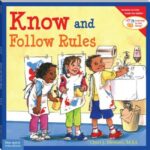Listens and Follows Directions
What does “Listens and Follows Directions” mean?
This skill is about a child’s ability to do what a parent or teacher asks them to do. The child shows they are listening to the adult giving the directions by following the instructions as best they can. Directions with two or three steps are appropriate for children in kindergarten. For example, “Push in your chair and put your plate in the sink.” Directions with too many steps can be confusing for young children and shouldn’t be used. This skill is important because it shows that the child can pay attention to what adults say and can follow instructions.
What does this skill look like?

At Home
After Marcus finishes eating his dinner, his dad asks him to bring his plate, fork, and cup to the sink. Marcus listens while his dad is talking. Then, he brings his plate, fork, and cup to the sink.

In The Classroom
Miguel’s teacher asks him to take off his coat and hang it on a hook. Miguel shows he is listening by quietly looking at his teacher. When his teacher is done giving directions, Miguel takes off his coat and hangs it on a hook.
 Children can see the value of “Listens and Follows Directions” in the book:
Children can see the value of “Listens and Follows Directions” in the book:
Know and Follow Rules
For more information about this book and other books that highlight this skill, visit our READING LIST page.
TIPS FOR FAMILIES
How can I explain this skill to my child?
Use the game Simon Says to help your child understand the value of listening and following directions. Tell your child that this game has a leader who gives directions and others who follow the directions. When you listen and follow the leader, you win the game!
What are some things I can do to help my child learn this skill?

Get your child’s attention before giving directions. Here are some things you can do to get your child’s attention:
- Make sure screens are paused or off (for example, TV, tablets, or phones).
- Call your child by name.
- Get down on your child’s level and make eye contact.
- Ask your child to do a few things they are likely to do first and then ask them to do something they are less likely to do. For example, you could say, “If you can hear me, clap your hands.” After the child claps, you could say, “Great, now pat your head.” After they pat their head, you could say, “Now touch your nose.” Finally, give a direction that they are less likely to follow like, “Please sit down.”
| Example Directions Children Are Likely to Follow: |
|---|
| Clap your hands, stomp your feet, jump |
| Touch your [nose, head, belly, toes] |
| Give me a [high-five or fist bump] |

Give clear and specific directions. Once you have your child’s attention, give clear and specific directions. Here are some examples of unclear directions and better ways to say them:
Unclear Directions | Clear and Specific Directions |
|---|---|
| “Let’s put away the toys.” | “Miguel, please put the blocks back on the shelf.” |
| “Why don’t you put your dishes in the sink?” | “Marcus, put your dishes in the sink.” |
| “Don’t make a mess!” | “Ava, please draw with your crayons on the paper.” |
In addition, make sure you:
- Remember not to give too many directions at once.
- Give directions slowly so your child has time to understand what you are asking them to do.
- Give your child time to follow your directions and do not jump in too quickly to do things for them.
- Build time into routines to make sure you aren’t rushed to do things for your child. For example, before school, plan for an extra ten minutes so your child can put on their own shoes.

Ask the child to repeat the directions you gave back to you. Asking your child to repeat directions back to you is an easy way to check that they listened and understood your instructions. After asking your child to do something you can say, “Miguel, can you tell me what I asked you to do?”

Try modeling what you are asking your child to do. When you ask your child to do something, tell and show them how. You can say, “Like this, Marcus,” and then demonstrate what you want them to do. This can help them understand exactly what you are asking and give them a model to copy.
How can I encourage my child when I see them trying to learn this skill?
Acknowledge your child for their efforts! For example, tell your child, “Miguel, you are doing a great job listening right now,” or “Marcus, you worked hard to put your toys away after I told you to clean up!” Click here for more ideas on how to encourage your child.
To download a printable PDF of the tips for this skill, click here.
TIPS FOR TEACHERS
How can I explain this skill to children?
You can explain the meaning and value of listening and following directions by talking to children about how important it is to pay attention to traffic lights. Traffic lights tell us when to stop and when to go. They help us stay safe when crossing the street. Tell children that the teacher is the traffic light for the classroom. The teacher tells you what to do so everyone stays safe and can focus on learning.
What are some examples of best practices from educational experts and fellow teachers?

Teach children to listen and follow directions through games and activities. At the beginning of the year, introduce games and activities focused on listening and following directions to develop and practice this skill. Revisit these games and activities all year to “tune up” children’s ability to listen and follow directions.
Games and activities to grow this skill:
- Simon Says or the Freeze Dance game.
- Tell and show children the “right way” to follow common directions. Talk through and act out what children should do when you say things like, “line up for lunch” (for example, push in my chair, walk to the line, and stand quietly keeping my hands to myself). Ask children WHY what you did was the “right way.” This helps ensure children know HOW to follow directions before you give them.
- Practice whole-group guided drawing. Give a sequence of directions to the class so each child can draw something like a flower. Pause between each direction to give children time to complete it (e.g., “First draw a circle at the top of the page.” [Pause] “Now, draw one line from the circle to the bottom of the paper”). Each child must follow your directions to draw the picture correctly and make sure that the class can create a larger picture, like a garden of flowers.
- Play a game where the class gets a point for every direction they follow as a group. If they get a certain number of points, the whole class gets a reward. For example, if everyone walks quietly in the hall on the way to lunch, the class gets a point. Once the class reaches 10 points, they get 10 extra minutes at recess.

Get children’s attention before giving directions. It is important to make sure children are listening before giving directions. Make sure you have their attention before asking them to do something. One good way to get a group of students to listen is to give them a few easy and fun practice instructions to follow. For example, you could say, “If you can hear me, clap your hands.” After the children have clapped, you could say, “Great, now pat your head.” After they pat their head, you could say, “Wonderful, now touch your nose.” Now that you have their attention, give them more important directions, such as, “Great, now sit quietly at your seat.”
| Example Directions Children Are Likely to Follow: |
|---|
| Clap your hands, stomp your feet, jump |
| Touch your [nose, head, belly, toes] |
| Give me a [high-five or fist bump] |
| Silly saying [One, two, three, eyes on me; Hocus pocus, everyone focus; Tootsie roll, lollipop, we’ve been talking, now let’s stop; Macaroni and cheese, everyone freeze!] |

Give clear and specific directions. Once you have children’s attention, give them clear and specific directions. Here are some examples of unclear directions and better ways to say them:
Unclear Directions | Clear and Specific Directions |
|---|---|
| “Let’s put away the toys.” | “Elijah, please put the blocks back on the shelf.” |
| “Why don’t you put your name on the paper?” | “Please write your name on the top of the paper, Aidan.” |
| “Don’t make a mess!” | “Isabelle, please draw with your crayons on the paper.” |
In addition, make sure you:
- Remember not to give too many directions at once.
- Give directions slowly.
- Give children time to respond (for example, try counting to ten to see if they will respond).
- Ask children to repeat the directions back to you.
- If a child does not follow your directions, try modeling it for them by saying, “like this” and demonstrating the direction.
How can I encourage children when I see them trying to learn this skill?
Acknowledge children for their efforts! For example, say, “Miguel, you did a great job listening to my instructions at circle time,” or “You worked really hard to clean up the room when I asked everyone to put the toys away, Marcus!” Click here for more ideas on how to encourage children.
To download a printable PDF of the tips for this skill, click here.

Start your morning with Conquering Kindergarten!
Hey teachers, want to incorporate Conquering Kindergarten into your community meeting each morning? Go to the district’s Community Meeting App to find ready-to-use slides highlighting this skill. Filter content in the app by Conquering Kindergarten or by a specific skill to get access to interactive and engaging slides tailored to the community meeting format.
To learn more about the tips and where they came from, please visit our references page.
